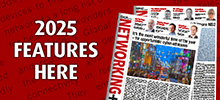07 May 2025

Criag Herrett, Managing Director Alliot Technologies LTD & Vadim Lyu, Managing Director UK & Ireland Netmore Group
The Internet of Things (IoT) industry has matured significantly, now providing crucial data-driven insights needed to truly optimize our daily environments. The ability to intelligently manage resources, reduce waste, and predict failures is becoming standard practice, showcasing the tangible benefits IoT can deliver.
The future promises even deeper integration and smarter automation across countless applications. Looking ahead, this deeper integration and smarter automation will unlock even greater potential, transforming how organizations operate. We are excited to be part of this dynamic era of change, and together with partners like Netmore and Alliot, look forward to shaping the future of IoT innovation.
Empowering resilient infrastructure
As the digital landscape grows more complex, critical infrastructure must evolve to meet rising demands for resilience, sustainability, and efficiency. Smart technologies, especially IoT solutions, are central to this evolution. They enable operators to transition from reactive management to predictive and autonomous systems.
By embedding sensors across key assets, organizations can obtain real-time insights into operational conditions, measuring environmental factors, energy usage, and system performance on a large scale. These insights are not merely for monitoring; they form the basis for informed decisions, faster response times, and better allocation of resources.
Predictive maintenance, driven by data analytics, marks a significant shift in infrastructure management. It allows issues to be identified and resolved before they cause failures, reducing downtime and extending asset life. This is more than a technical upgrade; it is a strategic move toward long-term resilience.
Reliable and secure connectivity is essential to this model. As smart infrastructure becomes more distributed, so too does the need for dependable networks that span a variety of environments, urban and remote alike. This is where low power wide area networks (LPWANs) are critical. They provide scalable, energy efficient communication to support thousands of devices across extensive areas.
Ultimately, adopting intelligent monitoring and automation is not about technology for its own sake. It is about building systems that are adaptive, responsive, and ready for future challenges.
Smarter, safer, greener schools
Beyond business and industry, IoT is also reshaping education. Schools are increasingly leveraging these technologies to foster safer, healthier, and more energy efficient learning environments. With dedicated efforts leading the way, smart school solutions are more accessible and effective than ever before.
In classrooms, IoT enabled systems regulate lighting, heating, and cooling based on occupancy and environmental conditions. This approach creates comfortable learning environments while significantly lowering energy usage. Air quality sensors monitor levels of carbon dioxide, humidity, and airborne particles to ensure that students and staff are breathing clean air.
Security is also enhanced, with real time monitoring and automated access control systems enabling schools to respond swiftly to incidents and maintain a secure perimeter.
Meanwhile, asset tracking solutions assist administrators in managing school resources more efficiently, reducing losses and improving utilisation.
A robust LoRaWAN infrastructure provides the connectivity backbone linking all devices. This is complemented by a complete technology stack, ranging from sensors and gateways to device management platform, ensuring seamless integration into school settings. Deep understanding of educational requirements guarantees that every project is purpose-built, easy to maintain, and scalable for future expansion.
IoT at work: transforming school and campus environments
Across schools and campuses, IoT is driving a new era of smarter, healthier, and more efficient learning environments. Educational institutions are now leveraging real-time data from a variety of sensors to create spaces that truly support student well-being and optimize building operations.
A standout example comes from campuses that have implemented IoT-based air quality monitoring systems. By continuously tracking parameters like carbon dioxide (CO₂), volatile organic compounds (VOCs), temperature, and humidity, these institutions can instantly detect when conditions become less than ideal for working and learning. Automated adjustments to HVAC systems help maintain optimal air quality, while early warning alerts empower staff to take immediate action if pollutant levels rise, ensuring occupants and faculty always have a safe and comfortable environment. Over time, the data collected enables institutions to identify patterns, address recurring issues, and make informed decisions about facility upgrades — all of which contribute to a healthier, more productive experience.
“As smart infrastructure becomes more distributed, so too does the need for dependable networks that span a variety of environments, urban and remote alike. This is where low power wide area networks (LPWANs) are critical. They provide scalable, energy efficient communication to support thousands of devices across extensive areas.”
Beyond air quality, IoT solutions are also used to monitor occupancy, regulate lighting and temperature, and even track energy and water consumption. For example, smart sensors can automatically dim lights or adjust heating in unoccupied rooms, significantly reducing energy costs and supporting sustainability goals. These systems not only improve the daily experience for students and staff but also help organizations manage resources more effectively and demonstrate a commitment to environmental stewardship.
The integration of IoT technologies is making it easier than ever for schools and campuses to adapt to the evolving needs of their communities.
The future of smart environments: a technological frontier
As IoT technology matures, the concept of ‘smart environments’ is rapidly evolving from a futuristic vision to a tangible reality. What’s driving this shift is not just the advancement of individual technologies, but their convergence to create interconnected ecosystems that can intelligently respond to our needs.
AI-driven automation enables smart environments to learn, adapt, and make autonomous decisions. Predictive analytics, powered by machine learning, optimizes energy consumption, predicts maintenance needs, and enhances security. Advanced sensor technologies expand the range of data that can be collected, from environmental conditions to human behaviour, enabling a deeper understanding of how people interact with their surroundings and how environments can be optimized to improve well-being and productivity.
The opportunities presented by these technological advancements are vast. From smart homes and buildings to smart cities and industrial facilities, the potential to create environments that are more efficient, sustainable, and responsive is limited only by our imagination. As the technology continues to evolve, we can expect to see even more innovative applications emerge, transforming the way we live, work, and interact with the world around us.










